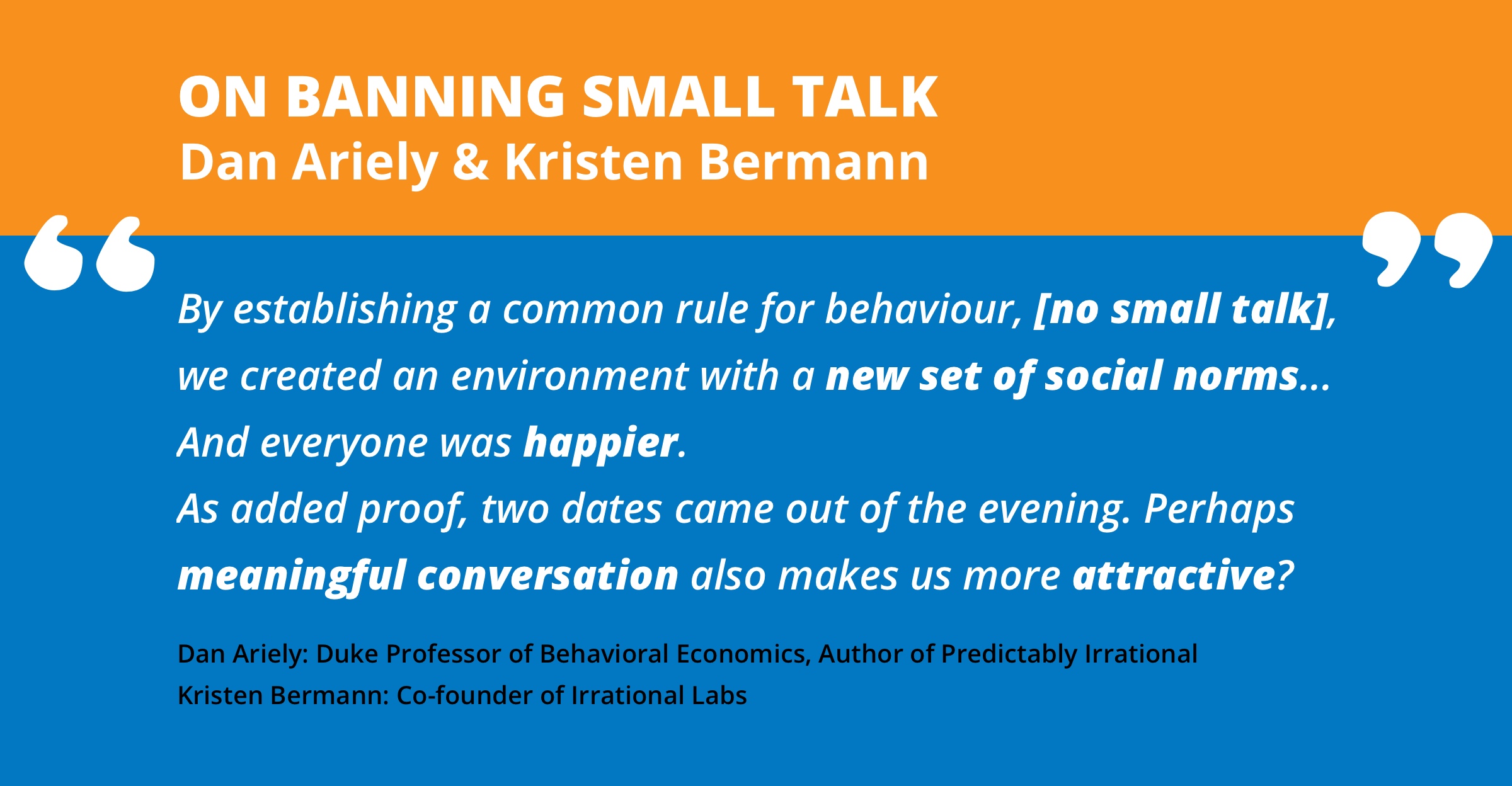Speakeasy Cards : Science
Excerpts from studies on creativity, thinking with images, ice breakers, social anxiety, & closeness
Images are already used in creativity training, business coaching, and design research.
They open up new thinking through metaphors, and trigger ideas that have been hard to conceptualise so far. (Zaltman, 2001)
- “…most communication occurs nonverbally (Weisner, 1988; Knapp, 1981; Seiter, 1987). That is, people “say” and “hear” a great deal more through nonverbal rather than verbal means of communication.”
- “…companies rely so much on verbally oriented research tools they often miss much of what customers “say” and “hear” nonverbally. “
- “The MET technique engages internal images, (neural patterns which underlie thought and feeling) and external images, (pictures, sounds, tastes, etc.) which represent or convey internal states of mind.”
- “All sensory images are important nonverbal means of communication.”
Research shows creative thinking in all fields occurs pre-verbally, before logic or linguistics. (Root-Bernstein, Bernstein, & Garnier, 1995)
- “Forty male scientists (including 4 who eventually won Nobel prizes) were interviewed four times between 1958 and 1978 concerning their work habits”
- “Significant correlations were found between scientific success and particular modes of thinking (especially visual ones), between success and various hobbies (especially artistic and musical ones)…”
- “We conclude that successful scientists have highly integrated networks of enterprise, whereas less successful colleagues tend to have fewer non-scientific activities that they do not integrate.”
CREATIVITY
VISUAL THINKING
Scientific problem-solving is facilitated by visual thinking. (Mathewson, 1999).
- “Thinking with images plays a central role in scientific creativity and communication but is neglected in science classrooms.”
- “A spatial image preserves relationships among a complex set of ideas as a single chunk in working memory, increasing the amount of information that can be maintained in consciousness at a given moment.”
- “Scientific creativity can be considered as an amalgam of three closely allied mental formats: images; metaphors; and unifying ideas (themes).”
- “Combinations of images, analogies, and themes pervade science in the form of “master images” and visualization techniques.”
But, after a productive day at the office, in left-brained email-and-execution mode, people don’t enter workshops or meetings geared up for innovation.
By engaging in a quick right-brain warm-up, we come back to feeling confident in our creativity.
While icebreakers might be cheesy, research shows they work — they encourage rapport, bring in humor, foster comfort, heightening whatever interactions that follow. (Chlup & Collins, 2010)
- Icebreakers “relieve inhibitions or tension between people…” “allowing those involved to build trust with and feel more open to one another.”
- “Icebreakers encourage participation by all, helping a sense of connection and shared focus to develop.”
- “Re-energizers can be used as transitions or a time to “clear the mind” encouraging vitality and enthusiasm (Boatman, 1991).”
- “[Icebreakers and re-energizers” also lead to a free exchange of information and enhanced communication between group members (Zwaagstra, 1997).”

What happened when Dan Ariely had a No Small Talk dinner?
CREATIVE WARM-UP
ICEBREAKERS
Because without cards, anyone can say anything in conversation. But having choice actually makes it difficult and frictioned — Where should you start?
Research shows we are much happier choosing when we have less options. It is easier to choose and we are less likely to regret it. (Iyengar & Lepper, 2000)
- With more options, people “feel more responsible for the choices they make, resulting in frustration with the choice-making process and dissatisfaction with their choices.”
- Study 1: “30% (31) of the consumers in the limited-choice (6 jar) condition subsequently purchased a jar of Wilkin & Sons jam; in contrast, only 3% (4) of the consumers in the extensive-choice (24 jar) condition did so.” “Moreover, participants actually reported greater subsequent satisfaction with their selections…” when they had less choice.
- Study 2: “Of the 70 students assigned to the limited-choice (6 topics) condition, 74% turned in the assignment. In contrast, of the 123 students assigned to the extensive-choice (30 topics) condition, only 60% chose to complete the assignment.” “… participants wrote better essays when their original set of options had been limited.”
And as someone who’s introverted and socially anxious, I’m more comfortable with curious, close conversations, and don’t feel connected when making small talk. Research shows this tends to be the case. (Kashdan & Roberts, 2006)
- People, regardless of anxiousness, have a similar level level of positive feeling in intimate conversations, while those who are anxious feel more negative in small-talk conditions.
- “In the small-talk condition, individuals with higher social anxiety reported significantly greater NA compared to individuals with lower social anxiety… No significant differences were found between individuals with higher and lower social anxiety in the closeness-generating condition.”
- “Individuals derive the greatest pleasure when they engage in social behaviors that are congruent with their behavior tendencies and sensitivities (i.e., dominant personality traits) and the least pleasure when they engage in social behaviors that are incongruent with their behavior tendencies (Côté & Moskowitz, 1998).”
CHOICE
SOCIAL ANXIETY
So, How do we get from everyday conversations to a deep or interesting one? Frequently by accident, when something unexpected happens, with tipsiness or overflowing excitement.
We’re often waiting for some invisible signal to tell us to move forward. What if we gave that permission directly?
When experimenters tell strangers to ask each other a list of increasingly intimate questions, they share real stories, and feel incredibly close to each other by the end. (Aron, 1997)
- “A practical methodology is presented for creating closeness in an experimental context.”
- “Over a 45-min period, subject pairs carry out self-disclosure and relationship-building tasks that gradually escalae in intensity. Study 1 found greater post-interaction closeness with these tasks versus comparable small-talk tasks.”
- “…immediately after 45 min of interaction, this relationship is rated as closer than the closest relationship in the lives of 30% of similar students.”
- In “brief follow-up questionnaires about 7 weeks after the study,” about “35% had done something together and 37% had sat together in class.”
–
How might we make interesting conversations more effortless? Let’s do it together.
Return to Kickstarter Campaign!How-To Guide (PDF)